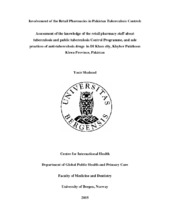| dc.description.abstract | Tuberculosis is the second leading cause of death globally from a contagious disease. Pakistan is at 4th position among the twenty two high TB burden countries. National tuberculosis control programme (NTP) Pakistan has acheived 100 % directly observed treatment short-course coverage in public sector but large proportion of TB patients take care from private sector, generally outside the system of NTP. NTP had taken various initiatives in TB control, including the engagement of the private sector. One of the important part of the private sector is retail pharmacies that has been mostly left out of public private mix activities. The NTP programme can get benefit from engaging private retail pharmacies for; screening of individuals with symptoms suggestive of TB and referring them to the TB control programme (case detection), supervised treatment, education, counselling and awareness. In order to attain these goals a baseline assessment of the knowledge, attitude and practices of the staff at the pharmacies is an essential pre- requisite. Methods and materials: The study was a cross- sectional survey which employed a questionnaire to collect the data from 82 private retail pharmacies through interviewing one staff member from each pharmacy with the longest experience by the principal investigator. SPSS was used for data entry and analysis. Results: All the staff members were male and only 4/82 pharmacies had a person with five year professional degree in pharmacy, 27/82 had received 2 years formal training as a pharmacy assistant, while 51/82 had not received any formal training in pharmacy. The majority of the pharmacies lacked records of the medicines sold to the patients and informational materials relevant to TB were present in only 38% pharmacies. The majority of pharmacy staff had resonable good information about TB prevention, anti-TB drugs administration and persistant cough as TB symptom but 66% lacked knowledge about MDR-TB and associated factors and no one had received any training about TB in the last two years. All the interviewed staff answered that frequently sold anti-TB drugs were combination preparation of 4 drugs (4-FDC-RHZE) or 2 drugs (2-FDC-RH) combinations. Almost 83% retail pharmacy staff answered that patients purchasing anti-TB drugs belong to a low socioeconomic class. Only 57% of pharmacy staff were aware of NTP while only 30% had heard of the TB DOTS strategy. Almost 80% of staff referred the suspected TB patients to chest physicians and no one referred suspected TB patients to TB DOTS center. Nearly 66% of the pharmacy staff wanted to know more about NTP and 83% were willing to be involved in TB control efforts by getting training and referring patients to the DOTS delivery facility. The results also revealed that there was a significant positive association between knowledge of TB, and the duration of working experience of pharmacy staff with the exception of MDR-TB related factors and duration of TB treatment. Conclusion: The research study revealed that it is feasible to involve private retail pharmacies in TB control and they can play a potential role in TB control by detecting and referring suspected TB patients to NTP DOTS centres, providing patient oriented services like adherence to the treatment,... | en_US |
